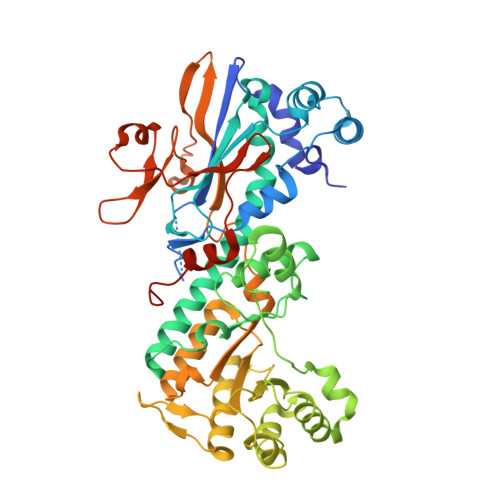Mechanism of Allosteric Modulation of Nicotinamide Phosphoribosyltransferase to Elevate Cellular NAD.
Ratia, K.M., Shen, Z., Gordon-Blake, J., Lee, H., Laham, M.S., Krider, I.S., Christie, N., Ackerman-Berrier, M., Penton, C., Knowles, N.G., Musku, S.R., Fu, J., Velma, G.R., Xiong, R., Thatcher, G.R.J.(2023) Biochemistry 62: 923-933
- PubMed: 36746631
- DOI: https://doi.org/10.1021/acs.biochem.2c00655
- Primary Citation of Related Structures:
8DSC, 8DSD, 8DSE, 8DSH, 8DSI, 8DTJ - PubMed Abstract:
In aging and disease, cellular nicotinamide adenine dinucleotide (NAD + ) is depleted by catabolism to nicotinamide (NAM). NAD + supplementation is being pursued to enhance human healthspan and lifespan. Activation of nicotinamide phosphoribosyltransferase (NAMPT), the rate-limiting step in NAD + biosynthesis, has the potential to increase the salvage of NAM. Novel NAMPT-positive allosteric modulators (N-PAMs) were discovered in addition to the demonstration of NAMPT activation by biogenic phenols. The mechanism of activation was revealed through the synthesis of novel chemical probes, new NAMPT co-crystal structures, and enzyme kinetics. Binding to a rear channel in NAMPT regulates NAM binding and turnover, with biochemical observations being replicated by NAD + measurements in human cells. The mechanism of action of N-PAMs identifies, for the first time, the role of the rear channel in the regulation of NAMPT turnover coupled to productive and nonproductive NAM binding. The tight regulation of cellular NAMPT via feedback inhibition by NAM, NAD + , and adenosine 5'-triphosphate (ATP) is differentially regulated by N-PAMs and other activators, indicating that different classes of pharmacological activators may be engineered to restore or enhance NAD + levels in affected tissues.
Organizational Affiliation:
Department of Pharmaceutical Sciences, College of Pharmacy, University of Illinois at Chicago (UIC), Chicago, Illinois 60612, United States.


















